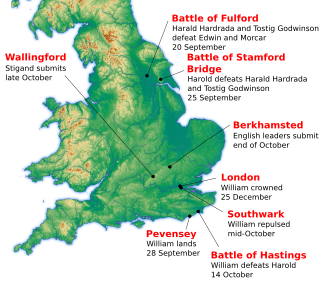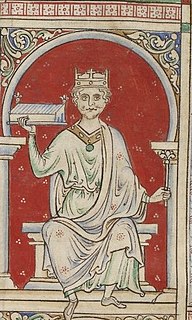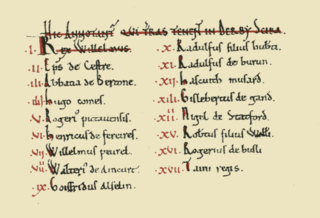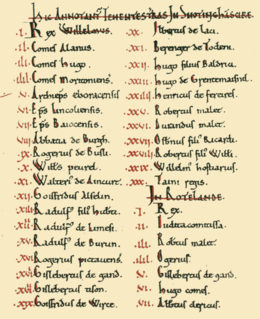Godwin of Wessex became one of the most powerful earls in England under the Danish king Cnut the Great and his successors. Cnut made Godwin the first Earl of Wessex. Godwin was the father of King Harold Godwinson and of Edith of Wessex, who in 1045 married King Edward the Confessor.

The Norman Conquest was the 11th-century invasion and occupation of England by an army made up of Normans, Bretons, Flemish, and men from other French provinces, all led by the Duke of Normandy later styled William the Conqueror.

Matilda of Flanders was Queen of England and Duchess of Normandy by marriage to William the Conqueror, and regent of Normandy during his absences from the duchy. She was the mother of ten children who survived to adulthood, including two kings, William II and Henry I.
Tostig Godwinson was an Anglo-Saxon Earl of Northumbria and brother of King Harold Godwinson. After being exiled by his brother, Tostig supported the Norwegian king Harald Hardrada's invasion of England, and was killed alongside Hardrada at the Battle of Stamford Bridge in 1066.

Stigand was an Anglo-Saxon churchman in pre-Norman Conquest England who became Archbishop of Canterbury. His birth date is unknown, but by 1020 he was serving as a royal chaplain and advisor. He was named Bishop of Elmham in 1043, and was later Bishop of Winchester and Archbishop of Canterbury. Stigand was an advisor to several members of the Anglo-Saxon and Norman English royal dynasties, serving six successive kings. Excommunicated by several popes for his pluralism in holding the two sees, or bishoprics, of Winchester and Canterbury concurrently, he was finally deposed in 1070, and his estates and personal wealth were confiscated by William the Conqueror. Stigand was imprisoned at Winchester, where he died without regaining his liberty.

The Battle of Fulford was fought on the outskirts of the village of Fulford near York in England, on 20 September 1066, when King Harald III of Norway, also known as Harald Hardrada, and Tostig Godwinson, his English ally, fought and defeated the Northern Earls Edwin and Morcar.

Odo of Rennes, Count of Penthièvre, was the youngest of the three sons of Duke Geoffrey I of Brittany and Hawise of Normandy, daughter of Richard I of Normandy. Eudon married Agnes of Cornouaille, the daughter of Alan Canhiart, Count of Cornouaille and sister of Hoel II, Duke of Brittany who was married in 1066 to Eudon's niece Hawise, Duchess of Brittany.

The Rebellion of 1088 occurred after the death of William the Conqueror and concerned the division of lands in the Kingdom of England and the Duchy of Normandy between his two sons William Rufus and Robert Curthose. Hostilities lasted from 3 to 6 months starting around Easter of 1088.

Gisa was Bishop of Wells from 1060 to 1088. A native of Lorraine, Gisa came to England as a chaplain to King Edward the Confessor. After his appointment to Wells, he travelled to Rome rather than be consecrated by Stigand, the Archbishop of Canterbury. As bishop, Gisa added buildings to his cathedral, introduced new saints to his diocese, and instituted the office of archdeacon in his diocese. After the Norman Conquest, Gisa took part in the consecration of Lanfranc, the new Archbishop of Canterbury, and attended Lanfranc's church councils. His tomb in Wells Cathedral was opened in the 20th century and a cross was discovered in his tomb.
Ivo Taillebois was a powerful Norman nobleman, sheriff and tenant-in-chief in 11th century England.

Remigius de Fécamp was a Benedictine monk who was a supporter of William the Conqueror.

Alan Rufus, 1st Lord of Richmond, was a Breton nobleman, kinsman and companion of William the Conqueror during the Norman Conquest of England. He was the second son of Eozen Penteur by Orguen Kernev. William the Conqueror granted Alan Rufus a significant English fief, later known as the Honour of Richmond, in about 1071.
Gilbert de Gant was the son of Ralph, Lord of Aalst near Ghent, and Gisele of Luxembourg, the sister-in-law of Baldwin IV, Count of Flanders. Gilbert de Gant was a kinsman of Matilda of Flanders, wife of William the Conqueror. He had two older brothers, Baldwin and Ralph. Gilbert of Ghent is mentioned in the Domesday Book of 1086 as having been given titles of 172 English manors but also within 14 shires where there were estates including York, Derby, Huntingdonshire, Leicestershire and Cambridgeshire.
William I of England has been depicted in a number of modern works.
Edward of Salisbury was a nobleman and courtier (curialis), probably part Anglo-Saxon, who served as High Sheriff of Wiltshire during the reigns of William I, William II and Henry I.
Walter Giffard, Lord of Longueville, Normandy, was a Norman baron, a Tenant-in-chief in England, a Christian knight who fought against the Saracens in Spain during the Reconquista and was one of the 15 or so known companions of William the Conqueror at the Battle of Hastings in 1066.
The feudal barony of Gloucester or Honour of Gloucester was one of the largest of the mediaeval English feudal baronies, in 1166 comprising 279 knight's fees, or manors. The constituent landholdings were spread over many counties. The location of the caput at Gloucester is not certain as Gloucester Castle appears to have been a royal castle, but it is known that the baronial court was held at Bristol in Gloucestershire.

Ansgar the Staller or Esegar was one of the wealthiest and most powerful nobles in late Anglo-Saxon England. He escaped badly wounded from the Battle of Hastings in October 1066, then led the defence of London.

The Domesday Book of 1086 AD lists King William the Conqueror's tenants-in-chief in Derbyscire (Derbyshire), following the Norman Conquest of England:

The Domesday Book of 1086 AD lists King William the Conqueror's tenants-in-chief in Snotinghscire (Nottinghamshire), following the Norman Conquest of England:












